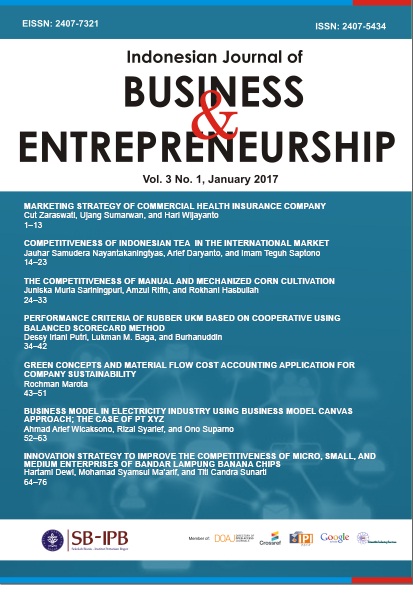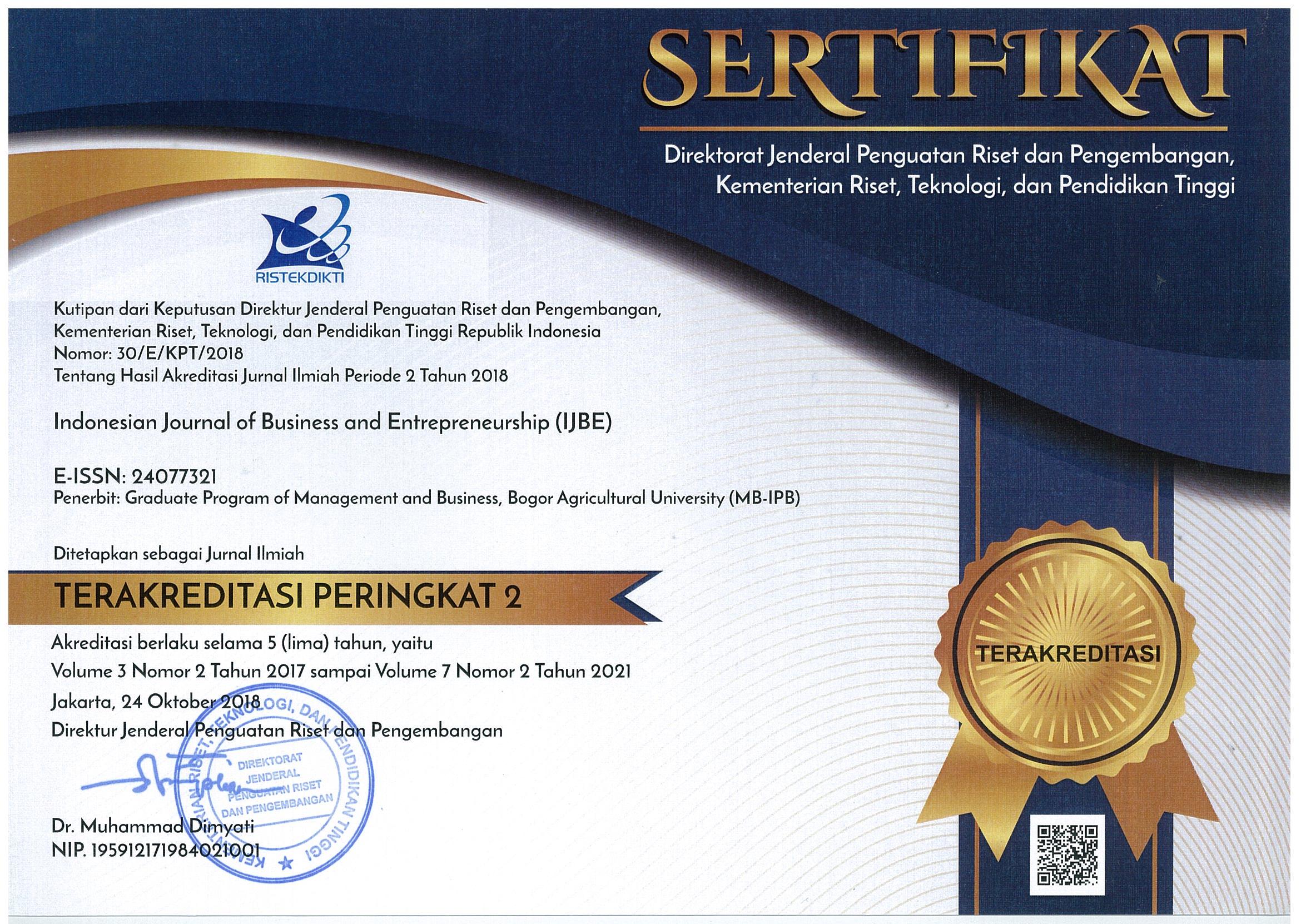COMPETITIVENESS OF INDONESIAN TEA IN INTERNATIONAL MARKET
Abstract
Since 2000, Indonesian tea has experienced a lot of problems such as land use change of plantation, lower selling prices, and low productivity. The objectives of this study are to analyze the competitiveness of tea in Indonesia and formulate priority improvements that can support the increasing competitiveness of Indonesian tea. The methods used to analyze the competitiveness were the Revealed Comparative Advantage (RCA) and the Export Product Dynamics (EPD), and to formulate strategies to increase competitiveness, Importance Performance Analysis (IPA) was applied. Based on RCA, the types of Indonesian tea which have strong competitiveness are HS 090 210 and HS 090240. The EPD analysis showed that only tea of HS 090210 is in the rising star position, while the HS 090220, HS 090230 and HS090240 tea types are on the retreat position. Based on IPA, sub-determinants which are priority to improve are in quadrant A (under act) consisting of five sub-factors, namely the availability of human resources with the capbility of production management, marketing and possess an entrepreneurial spirit; availability and ease of access to capital; strengthening of the structure of Indonesian tea agribusiness; the government policies in improving domestic demand conditions and in encouraging the development of tea processing industry.Keywords: competitiveness, tea, RCA, EPD, IPA
Downloads
References
Adam RP. 2011. Target pasar dan strategi memposisikan produk teh di pasar teh global. Media Litbang Sulteng 4(2): 125–136.
Adinugroho MF, Harmini. 2011. Transmisi harga teh hitam grade dust Indonesia. Forum Agribisnis 1(2): 183–199.
Ahtar W, Sharif M, Shah H. 2009. Competitiveness of Pakistani fruits in the world market. The Lahore Journal of Economics 14(2): 125–133.
Arifin B. 2013. On the competitiveness and sustainability of the Indonesian agricultural export commodities. ASEAN Journal of Economics, Management and Accounting 1(1): 81–100.
Batra A, Khan Z. 2005. Revealed Comparative Advantage: an Analysis for India and China. New Delhi: Indian Council For Research on International Economic Relations.
[BPS] Badan Pusat Statistik. 2015. Statistik Teh Indonesia 2014. Jakarta: Badan Pusat Statistik.
Farid A, Soemarno, Marsoedi, Setiawan B. 2013. Importance Performance Analysis of the marine tourism in Bawean Island, Indonesia. European Centre for Research Training and Development UK 1(2): 33–41.
Hasibuan AM, Nurmalina R, Wahyudi A. 2012. Analisis kinerja dan daya saing perdagangan biji kakao dan produk kakao olahan Indonesia di pasar internasional. Buletin RISTRI 3(1): 57–70.
Herlambang ES, Hubeis M, Palupi NS. 2011. Kajian perilaku konsumen terhadap strategi pemasaran teh herbal di Kota Bogor. Jurnal Pengembangan Manajemen Industri Kecil Menengah 6(2): 143–151.
Irawan B. 2007. Fluktuasi harga, transmisi harga dan marjin pemasaran sayuran dan buah. Analisis Kebijakan Pertanian 5(4): 358–373.
Kanaya IA, Firdaus M. 2014. Daya saing dan permintaan ekspor produk biofarmaka Indonesia di negara tujuan utama periode 2003-2012. Jurnal Manajemen & Agribisnis 11(3): 183–198.
Kathuria LM. 2013. Analyzing competitiveness of clothing export sector of India and Bangladesh, dynamic revealed comparative advantage approach. International Business Journal 23(2): 131–157.
Kuldilok SP, Dawson PJ, Lingard J. 2013. The export competitiveness of the tuna industry in Thailand. British Food Journal 115(3): 328–341.
Kustanti VR, Widiyanti T. 2007. Research on Supply Chain in The Tea Sector in Indonesia. Jakarta: The Business Watch Indonesia.
Martilla JA, James JC. 1977. Importance-performance analysis. Journal of Marketing 41(1):13–17.
Nabi I, Luthria M. 2002. Building Competitive Firms: Incentives and Capabilities. Washington: The World Bank.
Narulita S, Asmarantaka RW, Jahroh S. 2014. Analisis dayasaing dan strategi pengembangan agribisnis kopi Indonesia. Jurnal Agribisnis Indonesia 2(1): 63–74.
Natalia D, Nurozy. 2012. Kinerja daya saing perikanan Indonesia di pasar global. Buletin Ilmiah Litbang Perdagangan 6(1): 69–88.
Nurunisa VF, Baga LM. 2012. Analisis daya saing dan strategi pengembangan agribisnis teh Indonesia. Forum Agribisnis 2(1): 33–52.
Ozcelik SE, Erlat G. 2013. Turki's comparative advantage and dynamic market positioning in the EU market. Topic in Middle Eastern and African Economies 15(2): 42–70.
Porter ME. 1990. The Competitive Advantage of Nations. New York: Free Press.
Pradipta A, Firdaus M. 2014. Posisi daya saing dan faktor yang memengaruhi ekspor buah-buahan Indonesia. Jurnal Manajemen & Agribisnis 11(2): 129–143.
Puspita AAD, Baga LM. 2013. Analisis daya saing dan strategi pengembangan agribisnis gandum lokal di Indonesia. Jurnal Agribisnis Indonesia 1(1): 9–26.
Rifin A. 2013. Competitiveness of Indonesia’s cocoa beans export in the world market. International Journal of Trade, Economics and Finance 4(5): 279–281.
Savitri DA, Sumarwan U, Kurniawan BPY. 2014. Daya saing dan model pemasaran sentra industri usaha kerajinan sangkar burung perkutut. Jurnal Manajemen & Agribisnis 11(1): 24–32.
Shoufen C, Feng L, Jiao Z. 2011. Export competitiveness of agri-products between China and Central Asian Countries: A comparative analysis. Journal of Canadian Social Science 7(5): 129–134.
Sumitro R. 2012. Rapat pengurus Dewan Teh Indonesia. http://indoteaboard.org/z1/?p=571. [1 Oktober 2015].
Suprihatini R, Sa'id EG, Marimin, Mangunwidjaja D. 2005. Analisis kondisi komponen-komponen teknologi pengolahan di industri teh curah Indonesia. Jurnal Teknologi Industri Pertanian 14(3): 101–106.
Suprihatini R. 2005. Daya saing ekspor teh Indonesia di pasar teh dunia. Jurnal Agro Ekonomi 23(1): 1–29.
Suwandari A, Soetriono. 2010. Analisis kebijakan kopi robusta dalam upaya meningkatkan daya saing dan penguatan revitalisasi perkebunan. Jurnal Sosial Ekonomi Pertanian 4(3): 60–76.
Suprihatini R. 2015. Policies recommendations to safe Indonesian Tea Plantation. Di dalam: Prosiding International Conference Green Agro – Industry 2015: hlm 1-7.
[UNCOMTRADE] United Nations Commodity Trade Statistics Database. 2015. Export commodities based on HS code. http://comtrade.un.org/db/. [1 Oktober 2015].
Wong MS, Hideki N, George P. 2011. The Use of Importance-Performance Analysis (IPA) in evaluating Japan's e-government services. Journal of Theoretical and Applied Electronic Commerce Research 6(2): 17–30.
Yanti L, Widyastutik. 2012. Daya saing produk turunan susu Indonesia di pasar dunia. Jurnal Manajemen & Agribisnis 9(3): 183–193.
Zacharevic G, Dzemyda I. 2015. Global competitiveness of exporting business: the case study of Lithuania. Science - Future of Lithuania 7(2): 253–261. https://doi.org/10.3846/mla.2015.777.
Zuhdi F, Suharno. 2015. Analisis daya saing ekspor kopi Indonesia dan Vietnam di pasar ASEAN 5. Habitat 26(3): 152–162.









